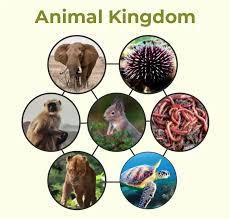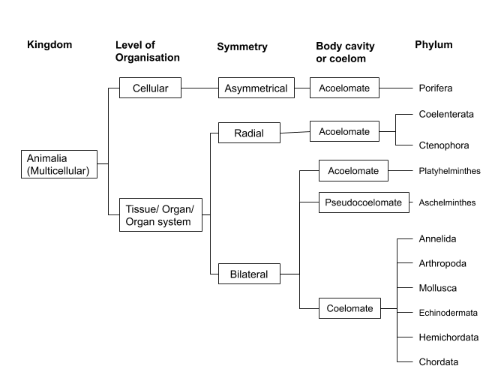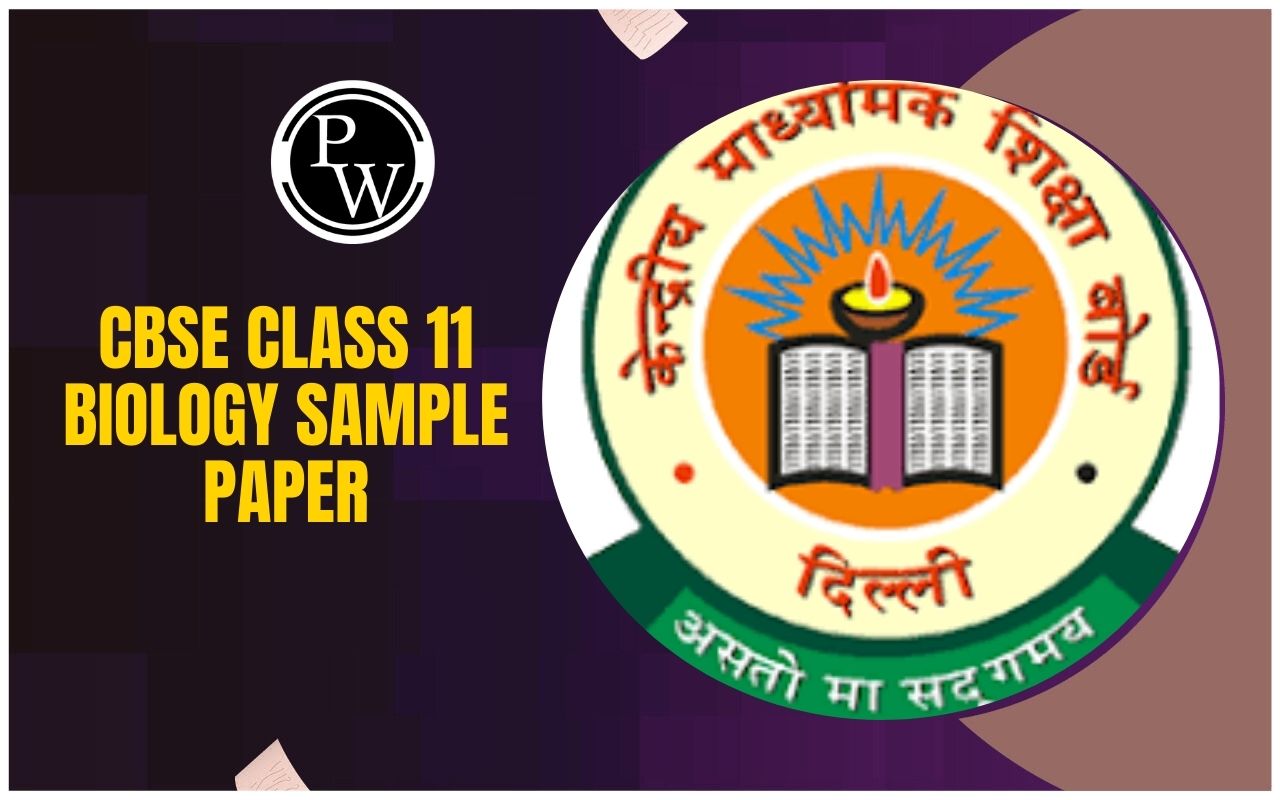
CBSE Class 11 Biology Notes Chapter 4: In class 11 biology chapter 4 notes talks about the Animal Kingdom. It's all about different types of animals and how we classify them. We look at things like their shape, if they have a backbone, and what their body is like inside.
We learn about lots of animal groups, from simple ones like sponges to more complex ones like mammals. This chapter helps us understand how animals are different from each other and how they've changed over time.CBSE Class 11 Biology Chapter 4 Notes
Animal Kingdom
 Animals are sorted out based on some key basic traits such as how their cells are arranged, the symmetry of their bodies, and if they have a coelom or not.
Animals are sorted out based on some key basic traits such as how their cells are arranged, the symmetry of their bodies, and if they have a coelom or not.
- Cellular level of organization: This is the simplest level, where cells are loosely put together, seen in creatures like sponges.
- Tissue level of organization: Cells doing the same job form tissues, seen in animals like coelenterates.
- Organ level of organization: Tissues group up to form organs that do specific jobs, like in flatworms.
- Organ system level of organization: Here, a bunch of organs work together for a particular function, seen in animals like annelids and arthropods.
- Open circulatory system: Blood is pumped out of the heart directly to the cells and tissues.
- Closed circulatory system: Blood moves around in a network of tubes like arteries, veins, and capillaries.
- Diploblastic: The embryo has two layers, like sponges and cnidarians.
- Triploblastic: The embryo has three layers, with mesoderm between the outer and inner layers, seen in animals from flatworms to chordates.
- Asymmetrical: No symmetry, like in sponges.
- Radial symmetry: The body can be split into equal halves by any plane passing through the center, seen in animals like jellyfish.
- Bilateral symmetry: The body can be split into equal left and right halves, seen in animals like worms and insects.
- Acoelomates: No body cavity, like flatworms.
- Pseudocoelomates: Their body cavity is filled with scattered pouches of mesoderm, like roundworms.
- Coelomates: They have a proper body cavity, seen in animals from segmented worms to vertebrates.
Classification of Animals

Classification of the Animal Kingdom based on common fundamental features
Phylum – Porifera (Sponges)
- Found in the ocean, asymmetrical shape, and cellular level of organization.
- They take in food, exchange gases, and excrete waste through water flow.
- Water enters through pores and exits through an opening called osculum.
- The inner cavity, spongocoel, is lined with collar cells or choanocytes.
- They have a skeleton made of spongin fibers or spicules.
- Sponges can reproduce both asexually and sexually, and they're hermaphrodites.
Phylum – Coelenterata (Cnidaria)
- Aquatic animals, either stationary or free-swimming, with tissue-level organization and radial symmetry.
- They have a central digestive cavity with a single opening surrounded by sensory tentacles.
- Special cells called cnidoblasts on tentacles contain stinging structures called nematocysts.
- Digestion is both inside and outside the body.
- Some have a hard skeleton made of calcium carbonate.
- They exist in two forms: polyps (sessile) and medusae (free-swimming).
- Some undergo alternation of generations, producing offspring asexually and sexually.
Phylum – Ctenophora (Comb jellies)
- Marine animals with tissue-level organization, radial symmetry, and no body cavity.
- They have eight rows of cilia-covered comb plates for locomotion.
- Digestion happens both inside and outside their bodies.
- Some species can produce light (bioluminescence).
- They can reproduce both sexually and externally, and they're hermaphrodites.
Phylum – Platyhelminthes (Flatworms)
- Mostly parasitic worms with flattened bodies, bilateral symmetry, and no body cavity.
- Parasites have hooks and suckers for attachment.
- They have flame cells for osmoregulation and excretion.
- Flatworms are hermaphrodites and can regenerate.
- Reproduction is both internal and through larval stages.
Phylum – Aschelminthes
- These are either free-living or parasitic, found in water or on land.
- They have round bodies, bilateral symmetry, and a pseudocoelom.
- Their digestive system is complete with a muscular pharynx.
- They reproduce sexually, with females usually longer than males.
- Examples include Ascaris (roundworm), Wuchereria (Filarial worm), and Ancylostoma (hookworm).
Phylum – Annelida
- These creatures have bilateral symmetry, a true coelom, and segmented bodies.
- Longitudinal and circular muscles aid in movement.
- They have closed circulatory systems and nephridia for waste removal.
- Reproduction is usually sexual, with some species being hermaphrodites.
- Examples are Pheretima (earthworm), Nereis, and Hirudinaria (bloodsucking leech).
Phylum – Arthropoda
- This is the largest phylum, containing insects.
- They have bilateral symmetry, a true coelom, and jointed legs.
- Their bodies are covered by a hard exoskeleton made of chitin.
- Respiration occurs through various methods like trachea, gills, or book lungs.
- They have open circulatory systems and compound or simple eyes.
- Examples include economically important species like Bombyx (silkworm) and disease vectors like mosquitoes.
Phylum – Mollusca
- These animals have bilateral symmetry, a true coelom, and a shell.
- They have distinct body parts like a head, foot, and visceral hump.
- Respiration and waste removal happen through feather-like gills.
- They have a rasping organ called a radula for feeding.
- Reproduction is usually sexual, with indirect development.
- Examples include Pila (apple snail), Octopus, and Pearl oyster.
Phylum – Echinodermata
- Adults show radial symmetry, while larvae have bilateral symmetry.
- They have a true coelom and an endoskeleton made of calcareous ossicles.
- Echinoderms have a unique water vascular system for various functions.
- Reproduction is usually sexual with indirect development.
- Examples include Asterias (starfish), Ophiura (brittle star), and Echinus (sea urchin).
Phylum – Hemichordata
- They have features similar to both chordates and invertebrates.
- They possess a structure called a stomochord resembling a notochord.
- Hemichordates have bilateral symmetry and a coelom.
- They reproduce sexually, with indirect development.
- Examples include Balanoglossus and Saccoglossus.
Phylum – Chordata
- Chordates are characterized by a hollow nerve cord, notochord, and gill slits.
- They have bilateral symmetry, a true coelom, and a closed circulatory system.
- Chordata is divided into three subphyla: Urochordata, Cephalochordata, and Vertebrata.
- Vertebrata is further divided into Agnatha (jawless) and Gnathostomata (jawed), which includes Pisces and Tetrapoda.
- Examples include various fish species, amphibians, reptiles, birds, and mammals.
Class I – Cyclostomata (Circular Mouthed Fishes)
- These fishes have a circular and sucking mouth without jaws.
- They are ectoparasites on other fishes.
- Cyclostomes have 6-15 pairs of gill slits, with no scales or fins.
- They have a cartilaginous vertebral column and closed circulation.
- Examples include Petromyzon (Lamprey) and Myxine (Hagfish).
Class II – Chondrichthyes (Cartilaginous fishes)
- These fishes have a cartilaginous endoskeleton and their mouth is on the ventral side.
- They lack operculum covering the gills.
- Chondrichthyes have placoid scales on their skin.
- They maintain buoyancy by constant swimming as they lack air bladders.
- Examples include Scoliodon (Dogfish), Trygon (Stingray), and Carcharodon (Great white shark).
Class III – Osteichthyes (Bony fishes)
- These fishes have a streamlined body with a bony endoskeleton.
- They possess cycloid scales on their skin.
- Osteichthyes have a two-chambered heart and an air bladder for buoyancy.
- Examples include marine species like Hippocampus (Sea horse) and freshwater species like Labeo (Rohu).
Class IV – Amphibia
- Amphibians can live both in water and on land.
- They typically have moist skin and lay eggs in water.
- Examples include frogs, salamanders, and limbless salamanders like Ichtthyophis.
Class V – Reptilia
- Reptiles are mostly terrestrial and have dry, cornified skin with scales or scutes.
- They lay eggs on land and have internal fertilization.
- Examples include crocodiles, alligators, chameleons, and snakes like Naja and Viper.
Class VI – Aves
- Birds have feathers for flying and their forelimbs are modified into wings.
- They have dry skin with oil glands and pneumatic bones for flight.
- Birds lay eggs with hard shells and exhibit internal fertilization.
- Examples include crows, pigeons, parrots, and flightless birds like ostriches.
Class VII – Mammalia
- Mammals are mostly terrestrial but some can fly or live in water.
- They have skin covered in hair or fur and mammary glands to feed their young.
- Mammals have a four-chambered heart and are warm-blooded.
- They give birth to live young and exhibit internal fertilization.
- Examples include kangaroos, cats, lions, and marine mammals like dolphins.
Benefits of CBSE Class 11 Biology Notes Chapter 4
-
These notes are prepared as per the CBSE Class 11 Biology syllabus so students can study in a structured way without missing important topics.
-
Well-organized CBSE Class 11 Biology Notes help in quick revision before exams and save time during preparation.
-
They are designed in simple language, making it easier to understand complex biological concepts.
-
Students can connect these notes with cbse class 11 pyq (previous year questions) to practice exam-oriented questions effectively.
-
Using these Chapter 4 notes ensures better conceptual clarity and boosts confidence for board exams as well as competitive exams.
CBSE Class 11 Biology Chapter 4 Animal Kingdom PDF Download
Our team of experts has created an easy-to-understand CBSE Class 11 Biology Notes Chapter 4 PDF. It helps you learn all about animals and how we classify them. You'll learn different ecosystems, like forests and deserts, and the animals that live there.
The notes explain the features of various animal groups, from simple ones like sponges to more complex ones like mammals. This study material is perfect for anyone learning biology in Class 11 and will make understanding the animal kingdom a breeze.
CBSE Class 11 Biology Chapter 4 Animal Kingdom
Study without using the internet
CBSE Class 11 Biology Notes Chapter 4 FAQs
What is the Animal Kingdom?
How are animals classified in the Animal Kingdom?
What are the different levels of organization in animals?
What are the major characteristics of different animal phyla?
What are some examples of animals in each phylum?










